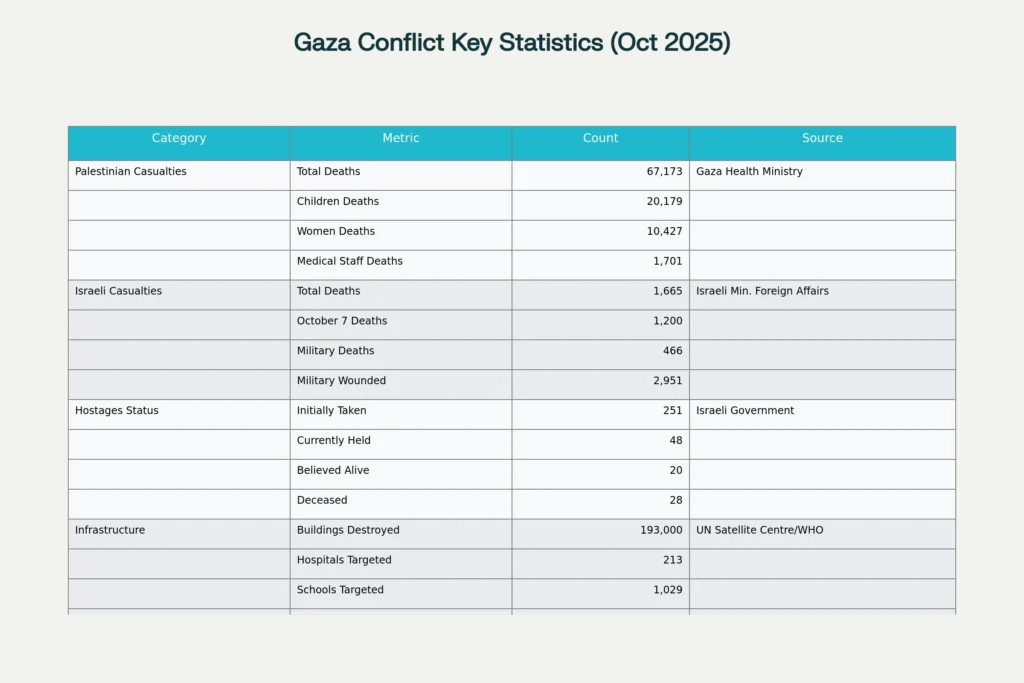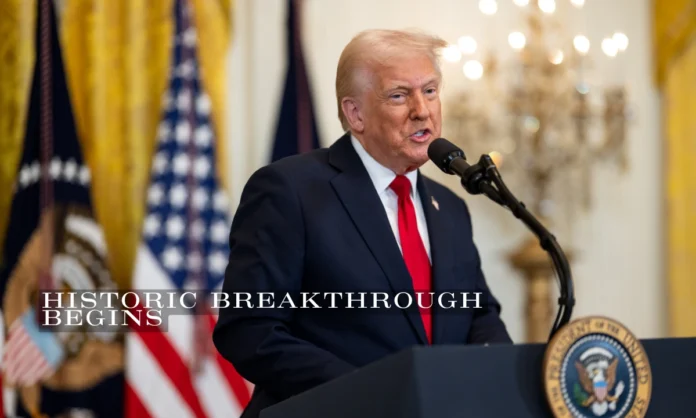Key Highlights
Trump Gaza Plan facilitates breakthrough negotiations between Hamas and Israel in Egypt, marking the first substantial diplomatic progress since the October 7, 2023 conflict began. The comprehensive Trump Gaza Plan demands immediate ceasefire, complete Hamas disarmament, and release of all 48 Israeli hostages within 72 hours of signing. International coalition of over 20 nations endorses Trump Gaza Plan, providing unprecedented diplomatic leverage with Qatar, UAE, Saudi Arabia, and European leaders backing the framework.
Opening Overview
President Donald Trump’s ambitious Gaza peace initiative has catalyzed the most significant diplomatic breakthrough in the Middle East conflict, with Hamas and Israeli delegations launching indirect negotiations in Egypt under the comprehensive Trump Gaza Plan framework. The historic talks, which commenced October 6, 2025, in Sharm el-Sheikh, represent the first substantive peace effort since Hamas’s October 7, 2023 attack that triggered the devastating two-year war. Trump Gaza Plan negotiations have gained unprecedented momentum through direct Presidential involvement, with special envoy Steve Witkoff and senior advisor Jared Kushner personally overseeing the mediation process alongside Egyptian and Qatari officials.
The Trump Gaza Plan’s 20-point framework has received extraordinary international support, creating diplomatic conditions absent from previous peace initiatives that failed to achieve lasting resolution. Egyptian intelligence sources confirm the first round concluded with “positive atmosphere,” indicating both Hamas and Israeli negotiators are engaging seriously with the Trump Gaza Plan’s comprehensive provisions for ceasefire implementation, hostage releases, and Gaza’s post-conflict reconstruction. This diplomatic initiative coincides symbolically with the October 7 anniversary, potentially transforming the conflict’s most painful memory into a foundation for lasting peace through the Trump Gaza Plan’s structured approach.
Trump Gaza Plan Framework and International Support
Implementation Timeline and Core Provisions
The Trump Gaza Plan establishes a three-phase implementation timeline starting with immediate ceasefire and hostage releases. International endorsement spans Arab League members, European Union leaders, and North American allies supporting the framework.
The Trump Gaza Plan’s comprehensive structure addresses core conflict issues through a detailed 20-point framework that demands Hamas’s complete disarmament and Gaza’s transformation into a “terror-free zone” under international oversight. Under the Trump Gaza Plan provisions, Hamas must release all 48 remaining Israeli hostages within 72 hours of agreement signing, while Israel commits to releasing approximately 1,950 Palestinian prisoners, including 250 serving life sentences for security-related offenses. The plan envisions Gaza’s governance transition to a technocratic Palestinian committee supervised by a “Board of Peace” directly chaired by President Trump, ensuring American oversight throughout implementation phases.
Global Coalition Building
International coalition building represents the Trump Gaza Plan’s greatest diplomatic achievement, with joint statements from Qatar, Jordan, UAE, Indonesia, Pakistan, Turkey, Saudi Arabia, and Egypt expressing “confidence in his ability to find a path to peace.” European leaders have embraced the initiative, with French President Emmanuel Macron, German Foreign Minister Johann Wadephul, and UK Prime Minister Keir Starmer welcoming the Trump Gaza Plan’s comprehensive approach, while Canadian Prime Minister Mark Carney described it as “historic.” This unprecedented international consensus provides the Trump Gaza Plan with diplomatic leverage that previous mediation efforts lacked, enabling pressure on both Hamas and Israeli leadership simultaneously.
The Trump Gaza Plan’s phased implementation begins with immediate humanitarian relief and prisoner exchanges, followed by Gaza’s reconstruction under international supervision and Hamas’s verified disarmament process. Hamas has indicated acceptance of key Trump Gaza Plan components including hostage releases and power transfer mechanisms, though critical details regarding disarmament verification and long-term security arrangements remain under active negotiation.
Negotiation Dynamics Under Trump Gaza Plan
Key Players and Mediation Structure
Hamas negotiator Khalil al-Hayya leads Palestinian delegation despite surviving recent Israeli assassination attempts. Israeli Strategic Affairs Minister Ron Dermer represents Netanyahu’s government in Trump Gaza Plan discussions.
The Trump Gaza Plan negotiations feature unprecedented high-level engagement, with President Trump personally stating he was “pretty sure” a peace deal was achievable and urging negotiators to accelerate progress under his framework. Trump’s direct involvement in the Gaza Plan represents a dramatic shift from previous administrations, establishing clear consequences for non-compliance while maintaining balanced pressure on both conflict parties. The administration has warned Hamas faces “obliteration” if it rejects the Trump Gaza Plan while simultaneously demanding Israel halt bombardment operations to facilitate diplomatic progress.
Regional Mediation Framework
Egyptian and Qatari mediators are coordinating the indirect discussions, with negotiators communicating through intermediaries rather than face-to-face meetings given recent Israeli strikes targeting Hamas leadership in Qatar. The Trump Gaza Plan’s mediation structure includes participation from Turkey and other regional powers, ensuring broader Muslim world engagement in implementation phases while maintaining American leadership throughout the process. Qatar’s Foreign Minister Mohammed bin Rahman Al Thani’s direct involvement provides additional regional legitimacy for the comprehensive approach.
Palestinian sources close to Hamas leadership acknowledge the Trump Gaza Plan negotiations will be “difficult and complex” given Israel’s continued military operations, with talks potentially extending several days to address fundamental disagreements. Israeli government statements confirm military operations continue for “defensive purposes” despite Trump Gaza Plan ceasefire calls, creating tension between diplomatic progress and ongoing violence that could undermine negotiation momentum. The timing coincides with the October 7 anniversary, adding symbolic weight that could either facilitate historical reconciliation under the Trump Gaza Plan or inflame emotions that derail peace efforts.
Egyptian intelligence officials report both sides are actively “discussing preparing ground conditions for the release of detainees and prisoners” as outlined in the Trump Gaza Plan framework, suggesting concrete progress beyond rhetorical commitments. The presence of Trump’s senior advisers alongside experienced regional mediators provides the high-level engagement necessary for breakthrough agreements under the comprehensive Trump Gaza Plan structure.
Humanitarian Crisis and Trump Gaza Plan Response

Key Statistics of the Gaza Conflict (October 7, 2023 – October 7, 2025)
Devastating Casualty Statistics
UN agencies document 67,173 Palestinian deaths including 20,179 children since conflict began. Trump Gaza Plan addresses immediate humanitarian access and reconstruction funding mechanisms.
The devastating humanitarian toll documented by international agencies underscores the urgent need for the Trump Gaza Plan’s immediate implementation, with Gaza Health Ministry reporting catastrophic casualties including 1,701 medical staff deaths since October 7, 2023. Israeli casualties total 1,665 deaths, including 1,200 from the initial Hamas attack and 466 military personnel killed in subsequent operations, while the conflict has displaced 1.9 million Palestinians representing 90% of Gaza’s population.
Infrastructure Destruction and Healthcare Collapse
Infrastructure destruction has reached catastrophic levels, with UN Satellite Centre analysis showing 193,000 buildings destroyed or damaged, 213 hospitals targeted, and 1,029 schools struck throughout the conflict. The Trump Gaza Plan recognizes that only 14 of Gaza’s 36 hospitals remain partially functional, creating overwhelming medical crises as facilities operate at 300% capacity, necessitating immediate international intervention under the plan’s humanitarian provisions. WHO has verified 668 attacks on healthcare facilities resulting in 886 fatalities and 1,355 injuries among medical personnel, statistics that have influenced the Trump Gaza Plan’s emphasis on protecting civilian infrastructure.
The malnutrition crisis has reached alarming levels with Famine conditions confirmed in Gaza Governorate, affecting over 500,000 people facing “catastrophic conditions characterized by starvation, destitution and death” according to WHO assessments. These statistics provide powerful motivation for negotiators to accept Gaza Plan’s comprehensive framework, with President Trump emphasizing that continued violence makes hostage rescue operations “far too dangerous” and demanding immediate cessation to enable humanitarian access. International aid workers have paid a devastating price, with 543 aid workers killed according to WHO Director-General statements, highlighting the extreme risks that seeks to eliminate through immediate ceasefire implementation.
The destruction of WHO’s main warehouse in Deir Al-Balah and critical shortages of 52% of essential drugs and 68% of medical disposables demonstrate the healthcare system’s complete collapse, reinforcing the Trump Gaza Plan’s emphasis on rapid humanitarian intervention and reconstruction funding. These documented crises provide compelling evidence for both Hamas and Israeli leadership to embrace the Trump Gaza Plan’s structured approach to ending the devastating conflict.
Final Perspective
The Egypt negotiations represent the most substantive diplomatic engagement since the conflict began, with the Trump Gaza Plan’s unprecedented international support and Presidential involvement creating conditions absent from previous peace initiatives. Hamas’s acceptance of key components, including hostage releases and governance transfers, combined with Israeli government preparation for “immediate implementation” suggests genuine momentum toward resolution under this comprehensive framework. The presence of Trump’s senior advisers and experienced regional mediators provides the high-level engagement necessary for breakthrough agreements under the detailed Plan structure.
However, fundamental challenges remain regarding Hamas disarmament verification, Gaza’s long-term governance mechanisms, and Israel’s security guarantees that could derail progress despite current optimism surrounding the Trump Gaza Plan. The continued Israeli military operations during negotiations, resulting in over 100 Palestinian deaths since Trump’s ceasefire call, demonstrates the fragile nature of diplomatic momentum and the critical need for immediate implementation. Success depends on both sides maintaining commitment to the framework while managing domestic political pressures and militant factions opposed to compromise.
The talks’ timing on the October 7 anniversary adds symbolic significance that could either facilitate historical reconciliation through the Plan or inflame emotions that undermine the negotiation process. With international attention focused on Egypt and President Trump personally invested in success, the coming days will determine whether the Trump Gaza Plan can achieve what previous diplomatic efforts could not: ending one of the Middle East’s most intractable conflicts through comprehensive, internationally-backed peace framework.


